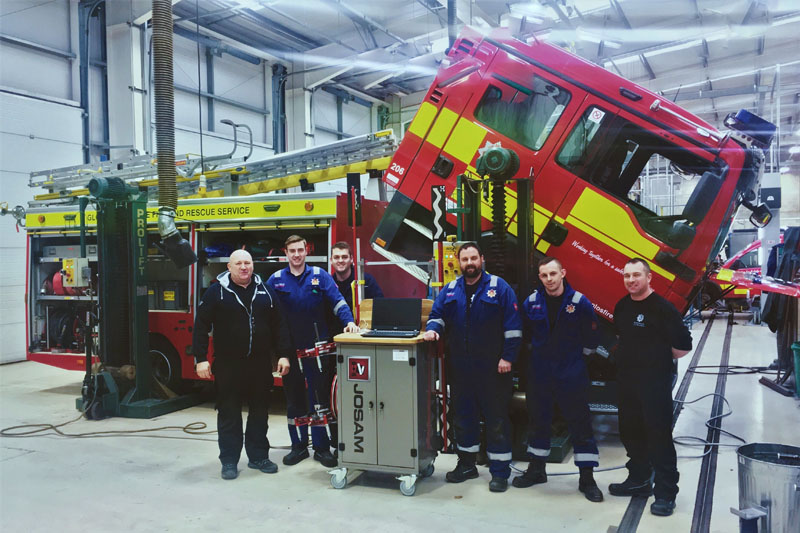
Gloucestershire Fire and Rescue Service explains how AES’ Josam wheel-alignment equipment improves the efficiency of its workshop, saving money and reducing emissions in the process.
In total, Gloucestershire Fire and Rescue Service runs a mixed fleet of 33 frontline HGV appliances, nine special appliances, including aerial platforms and 73 blue light non HGVs. The fire service decided on the Josam Cam-Aligner so its fleet could be regularly checked for correct wheel alignment and steering geometry.
“Our front-line firefighting appliances, all of which are heavy goods vehicles, and our blue-light response light vehicles, are often driven at high speeds when responding to a 999 emergency,” explains Nigel Leppard, Fleet Manager.
“As such, we must pay special attention to tyres, brakes, and steering, and this is where the Josam equipment plays its part.”
The compact Cam-Aligner system enables the fire service to quickly and accurately check wheel angles such as toe, camber, steering box middle, and axle offset. All of this is measured using Josam’s patented camera technology, using the chassis centre line as a point of reference.
Adam Fowles, Acting Workshop Manager, expands: “After AES took us through the basic on-site training, we found the Cam-Aligner quite simple to operate. It only takes about 20 minutes to carry out a routine inspection for each vehicle during its annual MOT, at which time any corrections can be made.
“If we need any ongoing advice, the AES support team are immediately on hand, and, most times, will sort things remotely, which is reassuring given that our vehicles must be on standby permanently.”
He goes on to say that any misalignments are easily adjusted, and the work detail is all recorded for later reference or auditing purposes. Furthermore, the Cam-Aligner allows the fleet to “handle better at high and low speeds, with the added benefit of saving on tyres, fuel, and vehicle down-time”.
Gloucestershire Fire and Rescue forecasts significant fuel savings which, given that each litre of diesel consumed produces 2.68kg of CO2, equates to a reduction in carbon emissions of approximately 72 tonnes per year. This will go a long way to help Gloucestershire County Council in its commitment to reduce carbon emissions in the county.
Nigel Leppard adds: “Not only do we maintain a high level of safety and compliance but, in the first five years, we expect to achieve vehicle and labour cost savings amounting to approximately four and a half times our capital outlay – with an initial return on investment in just 15 months.
“Carrying out this type of essential alignment work lessens the threat of going over budget by keeping down costs,” he concludes. “Furthermore, it reduces the threat of emergency vehicles being out of service, ensuring that we meet our legal obligation to VOSA by maintaining a legally compliant and safe fleet.”








